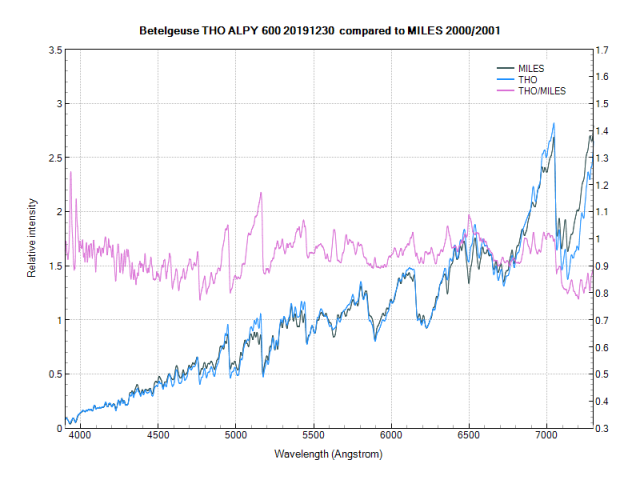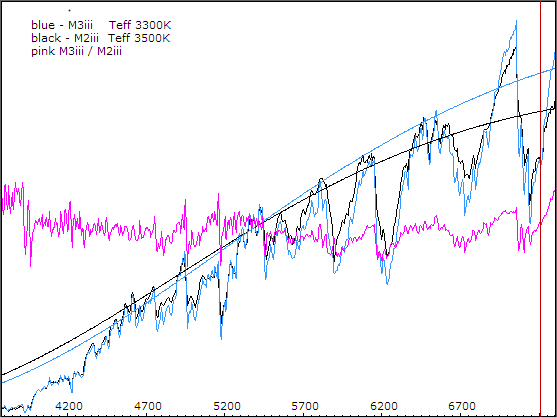› Forums › General Discussion › Betelgeuse
Tagged: Betelgeuse Leona occultation
- This topic has 97 replies, 23 voices, and was last updated 5 months ago by
 Robin Leadbeater.
Robin Leadbeater.
-
AuthorPosts
-
24 December 2019 at 3:05 pm #574480
 DawsonParticipant
DawsonParticipantFollowing on from Jeremy’s news article on Betelgeuse, what is the time frame of the supernova once it goes? How quickly will it appear to brighten, seconds, minutes, days? And once it is at its brightest, will it appear as a disk, or will it remain as a point source of light?
Thanks.
James
24 December 2019 at 4:55 pm #581818 Robin LeadbeaterParticipant
Robin LeadbeaterParticipantType II supernovae are a pretty heterogeneous bunch but a typical time to maximum at visible wavelengths is around 10 days. (Earlier at Gamma, a few hours when the shock wave breaks out? and Neutrinos even earlier) Assuming a velocity of explosion of say ~10000 km/s that gives a diameter of around 0.6 arcsec after 10 days if my back of envelope calculation is correct
24 December 2019 at 5:01 pm #581819 Dr Paul LeylandParticipant
Dr Paul LeylandParticipantIt depends entirely on how you look at it.
Neutrino telescopes will notice a great increase in brightness on the scale of seconds to a minute or few.
Optical telescopes will take a day or few, if the many thousands of other SNe which have been observed are anything to go by.
Betelgeuse already shows a disk if your telescope is good enough. It will show an ever bigger disk on timescales between days and millennia. Compare SN1054, the outside of which is now big enough to have been seen by Messier.
24 December 2019 at 5:12 pm #581821 Dr Paul LeylandParticipant
Dr Paul LeylandParticipantI see Robin and I posted pretty much simultaneously.
The neutrinos from SN1987a came in a clump a few seconds long. The telescope wasn’t very sensitive and the SN was at quite a distance so it’s likely that it saw only the very peak of the neutrino curve.
However, core collapse is a very rapid process, on the timescale of a minute or so (hence my prediction), and there is no obvious intense source of neutrino emission afterwards. Once the neutrinos get outside the core everything else lying in our direction is essentially transparent so they will not be scattered as is the initial burst of photons.
24 December 2019 at 6:24 pm #581823 Grant PrivettParticipant
Grant PrivettParticipantA supernova at that distance is going to be pretty bright. Are any wavelengths reaching us likely to cause problems?
Happy Christmas/Hannukah/Saturnalia/Yule/Solstice
24 December 2019 at 7:19 pm #581825 Dr Paul LeylandParticipant
Dr Paul LeylandParticipantYup.
All the professionals are going to be bugging us amateurs for telescope time because it saturates the detectors on all their equipment.
24 December 2019 at 8:46 pm #581826 Dominic FordKeymaster
Dominic FordKeymasterAs regards wavelengths causing problems, I think that’s very unlikely.
It’ll produce plenty of UV and X-ray photons, but assuming they come out uniformly in all directions, it wouldn’t have the power to do anything serious from a distance of 700 lyr. If it beamed them in a jet in our direction, that might be a different story. Luckily there’s strong evidence the rotational pole is inclined at an angle of about 20 degrees to our line of sight, and any jets would be directed out of the poles. So I think we can sleep easy.
But as Xilman says, the world’s professional astronomers may struggle to find high-resolution spectrographs that can deal with something that bright.
24 December 2019 at 10:46 pm #581827 Robin LeadbeaterParticipant
Robin LeadbeaterParticipantA point source that bright would be a problem for an amateur setup too but perhaps not if you defocus
http://www.threehillsobservatory.co.uk/astro/SA200_SEPSA_Vega.png
31 December 2019 at 7:11 pm #581845 David SwanParticipant
David SwanParticipantNot that often a variable star is featured on the BBC Radio 4 six o’clock news!
31 December 2019 at 7:24 pm #581846 Jeremy ShearsParticipant
Jeremy ShearsParticipantIndeed, David. Variable stars are of course fascinating and I am hoping the Beeb will now make a New Year’s Resolution to make this a weekly event…..
31 December 2019 at 7:33 pm #581847 David SwanParticipant
David SwanParticipantI thought that they covered the item reasonably well too. Hopefully everyone will be gazing south later this evening, peering through the firework smoke to look at Orion’s right shoulder…
1 January 2020 at 2:45 pm #581848 Robin LeadbeaterParticipant
Robin LeadbeaterParticipantInterestingly the changes in the spectrum are rather subtle considering the luminosity has roughly halved. Here is a current low resolution spectrum compared with one from the MILES library taken 2000/2001 when the V mag brightness was typically ~0.5
 1 January 2020 at 3:53 pm #581850
1 January 2020 at 3:53 pm #581850 David SwanParticipant
David SwanParticipantThanks Robin.
1 January 2020 at 6:43 pm #581851 Dr Paul LeylandParticipant
Dr Paul LeylandParticipantAny suggestions as to why that should be?
1 January 2020 at 11:34 pm #581854 Robin LeadbeaterParticipant
Robin LeadbeaterParticipantThe short answer is I don’t know. Perhaps the star’s photosphere has reduced in radius by ~30% (and hence halved in surface area) at approximately constant effective temperature ? The original Atel
http://www.astronomerstelegram.org/?read=13341
notes a small drop in Teff, indicated by an increase in the TiO band depths, which I am also seeing but the temperature drop quoted there does not seem to be sufficient on its own to explain the drop in luminosity. Since luminosity goes as T^4, the temperature would need to drop by ~%16 to halve the luminosity.
2 January 2020 at 10:28 am #581855 Dr Paul LeylandParticipant
Dr Paul LeylandParticipantIf the temperature had dropped I would expect the continuum to have shifted too — Wien´s law — though as that goes only as the first power of (1/T) perhaps the effect might be too small to be easily noticeable. I certainly haven´t noticed it from your spectra but there again, I don´t have much experience in these things.
I´m now wondering whether a neutral grey filter has interposed itself between us and the star. Something akin to the clouds of dust which appear in the atmospheres of RCB variables. The typical particle size would need to be significantly larger than the wavelength of light or we would see severe reddening.
Curious indeed.
2 January 2020 at 10:32 am #581856 Dr Paul LeylandParticipant
Dr Paul LeylandParticipantIf the radius dropped I would expect the temperature to rise, not fall, as the gravitational potential energy is converted to thermal kinetic energy.
Again, curious.
2 January 2020 at 1:56 pm #581858 Robin LeadbeaterParticipant
Robin LeadbeaterParticipantThe implication is that the contraction in this case could be the result of a reduction in energy production rather than the normal radial pulsation cycle. I am not convinced yet that we are in that situation though rather than the coincidence of the combined effect of the normal pulsations with different periods. If it keeps dropping though….
2 January 2020 at 3:44 pm #581859 Robin LeadbeaterParticipant
Robin LeadbeaterParticipantWein’s law is not too much help here as we are seeing just the tail of the black body distribution and stars like these are not really black bodies in any case due to the contribution of the deep absorption lines which varies with temperature
Looking at the Pickles standard spectra (see attached) The change in Betelgeuse looks to correspond to a change in spectral class of around 1-1.5 points eg M2 to M3.5 That is equivalent to a drop in Teff of around 200-300K
 2 January 2020 at 5:33 pm #581863
2 January 2020 at 5:33 pm #581863 Dr Paul LeylandParticipant
Dr Paul LeylandParticipantThanks for your in-depth explanations. I´m learning!
Although I’m a molecular spectroscopist by background I am emphatically NOT an astrophysicist. You (personally, not the generic “you”‘) can´t resolve the rotational and any hyperfine substructure of the molecular bands, which is where I cut my teeth. Not entirely sure that anyone can. Betelegeuse is bright enough for spectral resolutions of 100K-1M (my doctoral work was at a resolution of around 300,000) but do the physical conditions in the star’s atmosphere allow that kind of line resolution? That was a rhetorical question. I would be delighted to learn that rotational structure is readily observable, not least because the effective temperature of any species in question could then be nailed down to a very few Kelvin.
Roughly half my DPhil thesis concerned the rotational structure in the spectrum of CeO at ~2300K. Its spectrum is mind-bogglingly complex for such a simple diatomic molecule. There are at least eight low-lying electronic states with populations high enough to exhibit absorption spectra at 2300K. Well over 100K lines in the absorption spectrum between 300nm and 1200nm were measurable with 1980´s technology. CeO is also known to be an atmospheric constituent of a number of cool stars.
-
AuthorPosts
- You must be logged in to reply to this topic.
